 |

Tools:








GameStop – can they build a bridge before they hit the abyss?
We all are familiar with the problems GameStop is facing. They are totally invested in brick-and-mortar at a time when consumer begin to buy more and more new games from the publishers directly online. In other words, the action is shifting away from GameStop and is going towards the publishers of games such as Activision and Electronic Arts. Equally importantly, they do not appear to have a strategy to turn this online threat to their advantage and perhaps there is indeed none to be had.
GameStop's major money spinner is used games bought at their retail stores which are on a downwards slope given the fact that less and less new games are bought at retail which reduces the quantity of games that could be resold after use. There is another problem attached to this. A lot of old games are traded in for the newer ones and these old games just sit in inventory and cannot be resold – which leads to an increasing inventory overhang that will eventually force GameStop to take a severe haircut. We are already seeing this in their third quarter 2015 numbers which show that their inventory position increased from the 75.4 days a year earlier to now 84.7 days.
Their second money spinner is new games which, as pointed above, are shifting away from them. This leaves new consoles, their least profitable money maker, and this category is again expected to decline given the rapidly increasing use of smart phones for gaming.
And this is how GameStop's business segments developed worldwide to1/31/2016 [last quarter projected]:
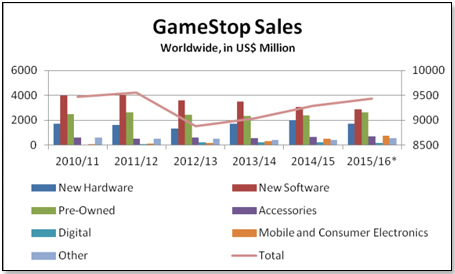
Source SEC Filings
In the most recent quarter, GameStop's U.S. sales were down by nearly 2% and operational earnings went down by 11%.
In contrast, this is how the overall U.S. brick-and-mortar market developed over the years:
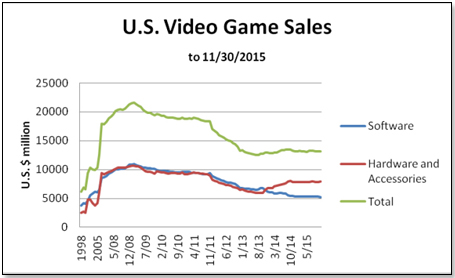
Source NPD
As we can see, the software segment has grown of late.
All indications are that GameStop is losing market share not only against downloads made directly from the Publishers but also against other brick-and-mortar retailers. The Klosters Retailer Panel metrics tell us who gained and who lost market share in the video game software space:
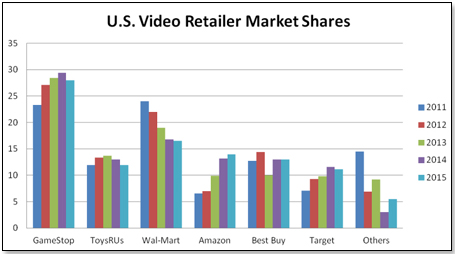
Source: Klosters Retailer Panel
The clear winner this year is Amazon. Wal-Mart and Best-Buy defended their 2014 market share, and GameStop, TRU , and Target lost out.
Why are the traditinal GameStop stores beginning to lose traction? Three reasons:
· GameStop is, contrary to its reputation, not doing particularly well in the consumer satisfaction stakes. According to a study carried out during the first quarter of 2015 amongst10,000 consumers by the Temkin Group, GameStop compared to its peers as follows:

To do worse than Wal-Mart in consumer satisfaction takes some doing and GameStop clearly has a problem there.
· GameStop is clearly not competitive in terms of pricing. I compared the top games of GameStop's with the same games offered by TRU. Firstly, TRU had exactly the same games on their shelves. Secondly, TRU was about one-third less expensive:
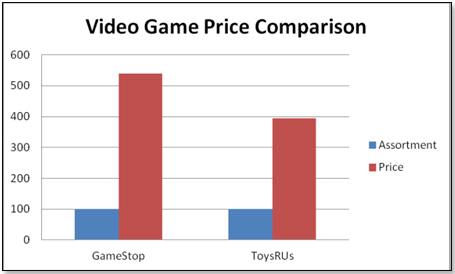
Source: Klosters Retailer Panel
· GameStop appears to be losing consumer interest overall as demonstrated by Social Media traffic measured by TickerTags:

GameStop management has recognized that they are in the wrong place with the wrong products and they are trying to change the equation. Their solution is their Technology Brand stores. The company launched the Technology Brands segment in 2013 when it acquired SimplyMac, a reseller of Apple products, and Spring Mobile, an AT&T authorized retailer of wireless products.
GameStop's Technology Brands segment also owns and operates Spring Mobile © , an authorized AT&T ® reseller operating AT&T branded wireless retail stores and pre-paid wireless services. In addition, GameStop entered last year into an alliance with Cricket Wireless, an AT&T subsidiary offering non-contract wireless services. As of October 31 this year, GameStop operated 834 Technology Brands stores and this increased to 1000 stores by mid December 2015.
The strategy is pretty clear. GameStop knows that the traditional video game store will sooner or later get to a point where they have lost the majority of video game sales to online transactions made by the publishers. As a consequence, they have opted for diversifying into the smart phone segment in the hope that the sales trajectory of these outlets will compensate for the sales decline of their traditional stores.
This strategy has two problems. One is that the Technology Brand stores are not doing particularly well as shown in the chart below:
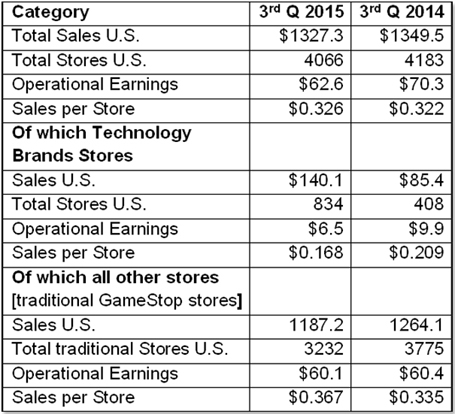
Overall, U.S. store sales declined by nearly 2% and operational earnings went down by 11%. However, Technology Brands stores pulled the whole U.S. performance further down. Their earnngs dropped by 35% and and sales per store were down 20%. The traditional stores performed much better in earnings and sales per store which both essentially were flat.
The challenges inherent in this situation are two-fold. For the strategy to work, Technology Brand store sales would need to grow much more quickly and this can up to a point be achieved by adding more stores as the company is doing. The other is operational earnings.To achieve a level similar to that obtaining for the traditional stores the Tech Brand outlets would need to boost sales per store by a factor of at least five times which is going to be very difficult, if not impossible.
The second problem inherent in the Tech Brand strategy is its product focus. It is totally centered on smart phones. In the U.S. there is already plenty of evidence that the market is nearing saturation point. According to a new Pew Research Center report titled "Technology Device Ownership: 2015", an overwhelming 92 percent of American adults own a cell phone (which may or may not be a smart phone), making it the most popular device available.
Laptops come next at 73 percent, but after smart phones (68 percent), the drop-off is quite precipitous — fewer than half of U.S. adults own a tablet computer, an MP3 player, or a game console, and less than one in five Americans can claim ownership of an e-reader or portable gaming device.
This is not to say that smart phone users will not need additional services or will not replace their current phones with newer versions further down the pike. But what it does tell me is that competition will as a result of a slowdown become much more price driven and aggressive – which does not bode too well for the future profitability of the Tech Brand stores.
In summary, traditional video game retailers such as GameStop are fighting a losing battle against technological change. To offset this, GameStop is trying to build up a parallel universe with their Tech Brand stores. The problem is that they are going from a place where they have a unique selling proposition to one which is awash with competition and which, too, is expected to decline.
I have learned a long time ago that a new retailer will only succeed if it offers something which is clearly different and more appealing to consumers compared to its more established competition and to do this in a growth environment ahead of the technological curve. None of these tenets seem to apply to GameStop's present strategy.
 Writer's Bio: Writer's Bio: Lutz Muller is a Swiss who has lived on five continents. In the United States, he was the CEO for four manufacturing companies, including two in the toy industry. Since 2002, he has provided competitive intelligence on the toy and video game market to manufacturers and financial institutions coast-to-coast. He gets his information from his retailer panel, from big-box buyers and his many friends in the industry. If anything happens, he is usually the first to know. Read more on his website at www.klosterstrading.com. Read more articles by this author
THIS BANNER IS AN AD:

Back to TDmonthly's front page
|  |
Advertise on TDmonthly

|

